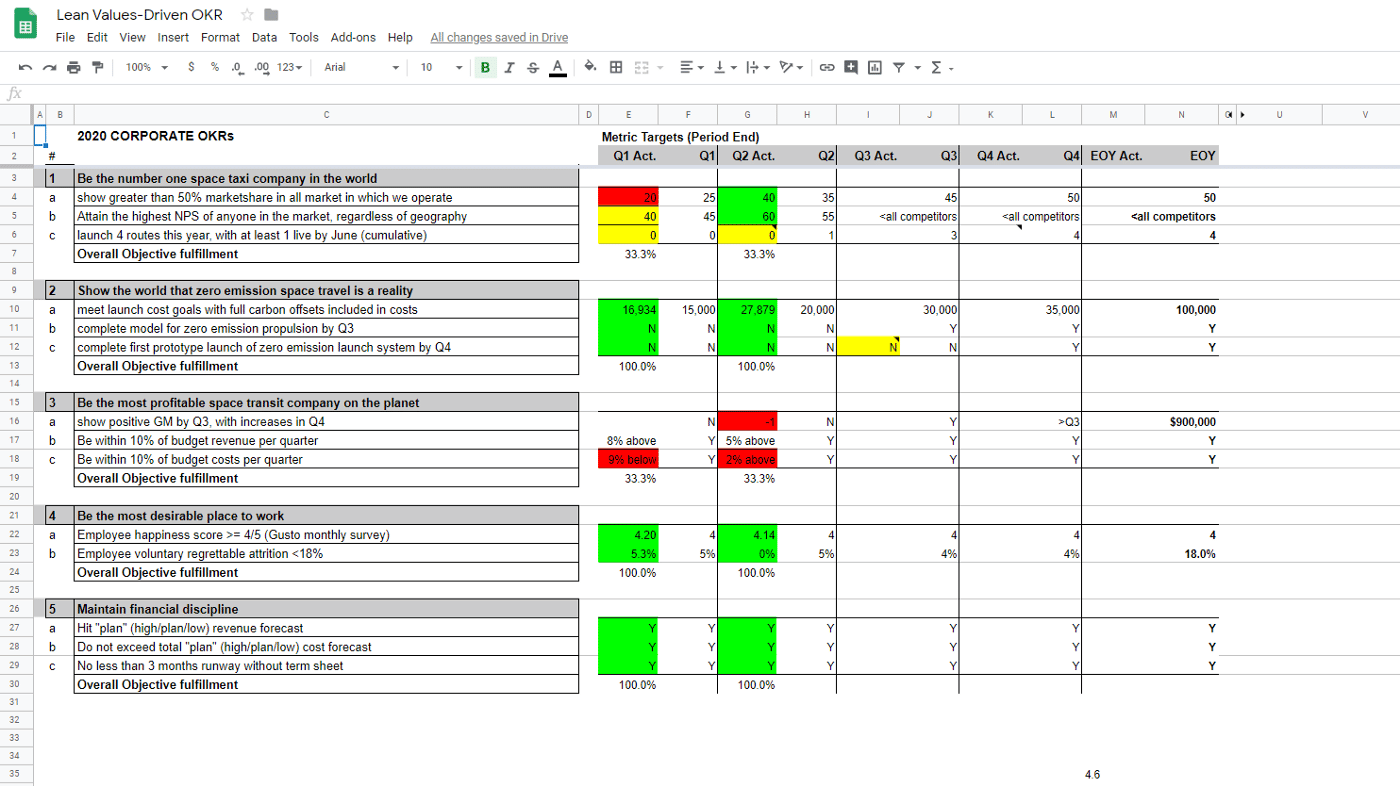A Modern Guide to Lean OKRs, Part III
Making it happen
Andrew Beebe |

The first steps are the hardest, and I find success in implementation is dramatically improved with a phased approach. First, plan and roll out your team-wide OKRs. Second, take the OKRs down a level in the organization. Finally, use OKRs at a personal level, and integrate them with performance reviews. I’ve seen companies do this all the way through within a year. However, even for agile start-ups, this can take longer.
Phase 1: Team-wide OKR rollout
Okay. It’s finally time for the rollout. You’ve done the proverbial “day locked in a room with your team” to hammer out what really measures success. You’ve now spent some time word-smithing these objectives and key results to ensure they adhere to the ever-critical RAMPS acronym (Relevant, Achievable, Measurable, Purposeful, and Specific). I find there’s often one person (Data junky? English major? Logic expert?) who is particularly good at drafting these to ensure enforceability crossed with digestibility. Hand it off, get it back, and give it one final reality-check. Perhaps spot check the one-pager with a few junior members of the team to ensure that digestibility.
Now find the right place to publish these OKRs.

One method is a homegrown google sheet. I’ve made a quick-and-dirty model which you are welcome to steal (found here) with a fake company called Intergalactic to give you a sense of the basic mechanics. Copy this sheet and make your own version (and share it with me for continuous improvement,, if you would). Purpose and values are listed in tabs upfront. Following these are the corporate OKRs, with filler divisional OKRs following. A few different formatting methods are shown, but the stoplight (red, yellow, green) model is used as a background color in the corporate OKRs to give you a sense of how to use visual cues in reporting.
Of course, there are also SaaS tools out there to help with this process. Ally, 15Five, Lattice and Workboard are just a few of your options. I find a shared spreadsheet can work just as well, but I’m sure these solutions will only get better over time.
Once these are in a universally accessible and persistent space, set up a regular review cycle. For most teams, quarterly is appropriate. Others will want to review once a month or just twice per year. Regardless of the schedule, stick to it. Nothing breeds mistrust and cynicism more than a major goal-setting effort which is not committed to from the top. Put these review dates on the calendar. Now. Then review them, evaluate objectively your success, and take corrective actions as needed. Additionally, you can reference select OKRs—in everything from executive team weekly meetings to the beginning of internal presentations—to keep them top of mind in the time between formal reviews.
That’s what it’s all about. Set, reflect, reset. Repeat.
Phase 2: Taking OKRs down a level
Now that the team is getting used to the leadership from the top on OKRs, it may be time to take things down a level. If you’ve been using team-wide OKRs for at least one full review cycle (two quarters, maybe four?), you may have certain teams asking why they can’t use these within their own organization. An easy first step for broader deployment is to ask one or two of these groups to try OKRs for a cycle or two. [An obvious pro-tip: go with a group that is inclined to experiment and most likely to embrace the process.] Alternatively, you can simply ask every team to employ OKRs.
There are two major pitfalls here, and they sum up most of the failures I’ve seen in OKR deployment.
- Training. Managers unfamiliar with the process of setting OKRs really need support and training upfront. Reading pieces like this or even longer form books such as Christina Wodtke’s Radical Focus can be helpful. However, training by someone within your team will be critical as well. This will help cement their OKRs into the corporate OKRs and allow for your particular cadence of OKR reviews to be embraced.
- Adherence. Teams will often get excited about OKR setting and fall into the mistaken belief that OKRs take the place of management. OKRs are simply a framework, but adherence and review still need disciplined management on top of them. This can be as simple as quarterly business reviews by team leads to the exec team, written reports, or even encouraging teams to place their OKRs as the first-slide in any/all presentation or action-oriented meeting.
So, as you push down your OKRs to the team-level, train your managers, and focus on adherence to review cycles.
Frequency. On the question of cycle spacing, there is no one answer. For earlier stage companies (Seed and Series A, say), I recommend annual company-wide OKRs, with teams attempting quarterly OKRs. This can be a way to ensure a regular pull-up and a clear connection to the company-wide goals. No one wants to wait four quarters to answer the basic question about their team: are we on track (at least at the team-level)? Later stage companies should be in a position to communicate quarterly out to the entire company with regard to how each group is doing. This is the concept designed into my template.
Phase 3: Personal OKRs and performance management
The final step in the OKR rollout journey is the use of OKRs at the individual level. In some ways, though the volume of OKRs you’ll need to track will increase, this can be the easiest level to implement. After all, since you’ve done company and team OKRs, your org should be well-versed in the methods such as RAMPS goal-setting and calendaring of OKR reviews.
There are, however, a few areas where personal OKRs differ and can get complex. At the most basic level, personal OKRs can help to cement one’s own success with that of the company’s success. Done right, this is empowering, since we all want to be part of the team’s overall success.
A key rule with all OKRs, but particularly personal ones, is to remember that this is about setting out your most important goals and results, not just “all important actions.” For many, this feels like a chance to enumerate the vast number of projects you’re involved with or actions you take in any given period. That’s not what this is about. That might fall into a weekly managerial reporting process, but it’s not what OKRs are all about. These objectives and key results should show the true measure of your success over a given period.
Starting with the annual goal-setting can help ensure the right outcome. By laying out the four or five big objectives for individuals in their role over the next year, you’ll be sure to avoid just talking about the description of everyone’s day-to-day actions. Then, by breaking these down into concrete quarterly goals, you should be able to connect the small milestones to those bigger outcomes.
If those individuals have personal development goals you may want to note these as private goals, not meant for sharing. For example, they may have the following goal: “Prove to the VP of Marketing that I have the leadership skills necessary to become a Director, as measured by Jane during my performance review.” Yet, they’re not ready to share this with the entire team. Encourage them to work with managers to ensure that certain goals are kept private.
Transparency
As noted above, there will be cases where certain goals are best left private. However, in general, I have seen Lean OKRs work better when teams are as transparent as possible with their goals. This can mean printing them and posting them on your cube (personal goals), on the wall (for team goals), or elsewhere like Slack for all the above.
A Parting Note on Management
OKRs are not some magical operating system which obviates the need for management skills. This isn’t blockchain for leadership. We all still need to lead and manage our teams. We need to coach, communicate, and solicit / give constructive feedback. OKRs are just a tool to help us do so in a way that is more fair, transparent and hopefully effective.
Good luck out there. Let us know how it goes.
[This was Part III in a three-part series. You can find Part I here and Part II here.]



